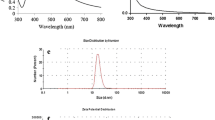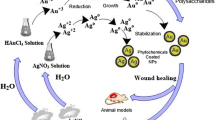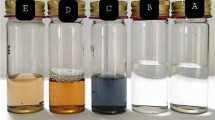Abstract
The present study evaluates in vitro cytotoxic effects and the mode of interaction of biologically synthesized Ag and Au nanoparticles (NPs) using Brassica oleracea L. var. capitata f. rubra (BOL) against HT-1080 cancer cells and bacterial cells as well as their wound healing efficacy using a mouse model. UV–visible spectroscopy, scanning electron microscopy, high-resolution transmission electron microscopy, and energy-dispersive X-ray analysis have ascertained the formation of nano-sized Ag and Au particles. Fourier transform infrared analysis has confirmed that polyphenol and amide groups in BOL act as capping as well as reducing agents. The free radical scavenging activity under in vitro conditions is found to be higher for the Ag NPs when compared to the Au NPs. Acridine orange–ethidium bromide dual staining and comet assay have indicated that the cytotoxic effects are mediated through nuclear morphological changes and DNA damage. The intracellular localization of Ag and Au NPs in HT-1080 cells and their subsequent effect on apoptosis and necrosis were analyzed by flow cytometry while the mode of interaction was established by scanning electron microscopy under field emission mode and by bio-transmission electron microscopy. These methods of analysis clearly revealed that the Ag and Au NPs have easily entered and accumulated into the cytosol and nucleus, resulting in activation of inflammatory and apoptosis pathways, which in turn cause damage in DNA. Further, mRNA and protein expression of caspase-3 and caspase-7, TNF-α, and NF-κB have provided sufficient clues for induction of intrinsic and extrinsic apoptosis and inflammatory pathways in Ag NP- and Au NP-treated cells. Evaluation of wound healing properties of Ag and Au NPs using a mouse model indicates rapid healing of wounds. In addition, no clear toxic effects and no nuclear abnormalities in peripheral blood cells are observed. Ag NPs appear to be a better anticancer therapeutic agent than Au NPs. Nonetheless, both Ag NPs and Au NPs show potential for promoting topical wound healing without any toxic effects.

Schematic representation of biological synthesis of Ag and Au NPs and its application on cancer and wound healing:











Similar content being viewed by others
References
Ahmed MF, Rao A (2014) Simultaneous determination of phenolic compounds in Brassica oleracea L. var capitata. by high-performance liquid chromatography. Int J Pharm Pharm Sci 6:534
Brand-Williams W, Cuvelier ME, Berset CLWT (1995) Use of a free radical method to evaluate antioxidant activity. LWT-Food Sci Tech 28:25
Foldbjerg R, Olesen P, Hougaard M, Dang DA, Hoffmann HJ, Autrup H (2009) PVP-coated silver nanoparticles and silver ions induce reactive oxygen species, apoptosis and necrosis in THP-1 monocytes. Toxicol Lett 190:156
Guo H, Qian H, Idris NM, Zhang Y (2010) Singlet oxygen-induced apoptosis of cancer cells using upconversion fluorescent nanoparticles as a carrier of photosensitizer. Nanomed Nanotech 6:486
Hu W, Lee SK, Jung MJ, Heo SI, Hur JH, Wang MH (2010) Induction of cell cycle arrest and apoptosis by the ethyl acetate fraction of Kalopanax pictus leaves in human colon cancer cells. Bioresour Technol 101:9366
Jeyaraj M, Rajesh M, Arun R, MubarakAli D, Sathishkumar G, Sivanandhan G, Dev GK, Manickavasagam M, Premkumar K, Thajuddin N, Ganapathi A (2013a) An investigation on the cytotoxicity and caspase-mediated apoptotic effect of biologically synthesized silver nanoparticles using Podophyllum hexandrum on human cervical carcinoma cells. Colloids Surf B Biointerfaces 102:708
Jeyaraj M, Sathishkumar G, Sivanandhan G, MubarakAli D, Rajesh M, Arun R, Kapildev G, Manickavasagam M, Thajuddin N, Premkumar K, Ganapathi A (2013b) Biogenic silver nanoparticles for cancer treatment: an experimental report. Colloids Surf B Biointerfaces 106:86
Kulandaivelu B, Gothandam KM (2016) Cytotoxic effect on cancerous cell lines by biologically synthesized silver nanoparticles. Braz Arch Boil technol 59:1
Kumar CG, Mamidyala SK (2011) Extracellular synthesis of silver nanoparticles using culture supernatant of Pseudomonas aeruginosa. Colloids Surf B 84:462
Lafon-Hughes L, Di Tomaso MV, Mendez-Acuna L, Martınez-Lopez W (2008) Chromatin-remodelling mechanisms in cancer. Mutat Res 658:191
Lakshmi S, Dhanya GS, Joy B, Padmaja G, Remani P (2008) Inhibitory effect of an extract of Curcuma zedoariae on human cervical carcinoma cells. Med Chem Res 17:335
Liu H, Xu Y, Wen S, Zhu J, Zheng L, Shen M, Zhao J, Zhang G, Shi X (2013) Facile hydrothermal synthesis of low generation dendrimer-stabilized gold nanoparticles for in vivo computed tomography imaging applications. Polym Chem 4:1788
Livak KJ, Schmittgen TD (2001) Analysis of relative gene expression data using real-time quantitative PCR and the 2−ΔΔCT method. Methods 25:402
Nasongkla N, Bey E, Ren J, Ai H, Khemtong G, Guthi JS, Chin SF, Sherry AD, Boothman DA, Gao J (2006) Multifunctional polymeric micelles as cancer-targeted, MRI-ultrasensitive drug delivery systems. Nano Lett 6:2427
Pardee AB, Stein GS (2011) The biology and treatment of cancer: understanding cancer. Wiley, Hoboken
Percival SL, Bowler PG, Russell D (2005) Bacterial resistance to silver in wound care. J Hosp Infect 60:1
Pradeep T (2009) Noble metal nanoparticles for water purification: a critical review. Thin Solid Films 517:6441
Ramar M, Manikandan B, Marimuthu PN, Raman T, Mahalingam A, Subramanian P, Karthick S, Munusamy A (2015) Synthesis of silver nanoparticles using Solanum trilobatum fruits extract and its antibacterial, cytotoxic activity against human breast cancer cell line MCF 7. Spectro chimica Acta A 140:223
Saha K, Agasti SS, Kim C, Li X, Rotello VM (2012) Gold nanoparticles in chemical and biological sensing. Chem Rev 112:2739
Salunke GR, Ghosh S, Kumar RS, Khade S, Vashisth P, Kale T, Chopade S, Pruthi V, Kundu G, Bellare JR, Chopade BA (2014) Rapid efficient synthesis and characterization of silver, gold, and bimetallic nanoparticles from the medicinal plant Plumbago zeylanica and their application in biofilm control. Int J Nanomedicine 9:2635
Sharma G, Sharma AR, Kurian M, Bhavesh R, Nam JS, Lee SS (2014) Green synthesis of silver nanoparticle using Myristica fragrans (nutmeg) seed extract and its biological activity. Dig J Nanomater Biostruct 9:325
Singh NP, McCoy MT, Tice RR, Schneider EL (1988) A simple technique for quantitation of low levels of DNA damage in individual cells. Exp Cell Res 175:184
Singh J, Upadhyay AK, Bahadur A, Singh B, Singh KP, Rai M (2006) Antioxidant phytochemicals in cabbage (Brassica oleracea L. var. capitata). Sci Hortic-Amsterdam 108:233
Singh S, Jain DVS, Singla ML (2013) Sol–gel based composite of gold nanoparticles as matix for tyrosinase for amperometric catechol biosensor. Sensor Actuat B-Chem 182:161
Sivakumar AS, Anuradha CV (2011) Effect of galangin supplementation on oxidative damage and inflammatory changes in fructose-fed rat liver. Chem Biol Interact 193:141
Sivakumar AS, Ochirbat C, Cho SH, Yang J, Hwang I (2014) Antiapoptotic effect of a novel synthetic peptide from bovine muscle and MPG peptide on H2O2-induced C2C12 cells. In vitro cell dev biol anim 50:630
Vivek R, Thangam R, Muthuchelian K, Gunasekaran P, Kaveri K, Kannan S (2012) Green biosynthesis of silver nanoparticles from Annona squamosa leaf extract and its in vitro cytotoxic effect on MCF-7 cells. Process Biochem 47:2405
Woolfenden BS, Wilson RL (1982) Radical cations as reference chromogens in studies of one-electron transfer reactions: pulse radiolysis studies of 2, 2-azinobis-(3-ethylbenzthiazoline-6-sulfonate). J Chem Soc Perkin Trans:805–812
Acknowledgements
The TEM and SEM samples were analyzed using the JEM-2010 (JEOL) installed at the Center for University-Wide Research Facilities (CURF) at Chonbuk National University. We thank Mrs. Eun-Jin Choi at the CURF at Chonbuk National University.
Author information
Authors and Affiliations
Corresponding author
Ethics declarations
All procedures relating to the animals and their care conformed to the international guideline “Principles of Laboratory Animals Care” (NIH Publication No. 85-23, revised 1985).
Additional information
Editor: Tetsuji Okamoto
Electronic supplementary material
Fig. S1
UV–visible spectra of the biosynthesized Ag NPs and Au NPs observed at 430 nm. Digital photographs showing the (A) leaf extract alone, (B) reddish dark brown color formation of Ag NPs after the addition of 1 mM AgNO3 into the aqueous Brassica oleracea L. var. capitata f. rubra extract, and (C) light brownish color formation of Au NPs after the addition of 1 mM HAuCl4 into the aqueous plant extract. (JPEG 85 kb)
Fig. S2
FE-SEM images of the Ag and Au NPs observed after the addition of 1 mM AgNO3 and 1 mM HAuCl4 into the aqueous BOL extract: (a) Ag NPs and (b) Au NPs. (JPEG 173 kb)
Fig. S3
Energy-dispersive X-ray analysis performed on the biosynthesized Ag and Au NPs: (a) Au NPs and (b) Ag NPs. (JPEG 42 kb)
Rights and permissions
About this article
Cite this article
Sivakumar, A., Krishnaraj, C., Sheet, S. et al. Interaction of silver and gold nanoparticles in mammalian cancer: as real topical bullet for wound healing— A comparative study. In Vitro Cell.Dev.Biol.-Animal 53, 632–645 (2017). https://doi.org/10.1007/s11626-017-0150-5
Received:
Accepted:
Published:
Issue Date:
DOI: https://doi.org/10.1007/s11626-017-0150-5




